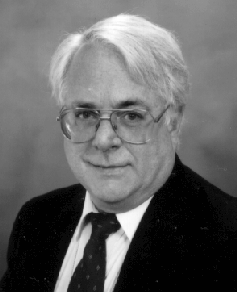
Spring/Summer 1999
Volume 6, Issue 2
Spring/Summer 1998
Volume
3, Issue 1
January 1995
Volume
2, Issue 4
October 1994
Volume
2, Issue 1
January 1994
EAC FOCUS
Donald M. Austin
Assistant Director for Planning, National Coordination Office for High Performance Computing and Communications
 Donald Austin graduated magna cum laude with a B.S. in Mathematics and
Physics from Memphis State University in 1964 and his Ph.D. in
Theoretical Physics from Iowa State University in 1969. He worked as a
postdoctoral fellow in Theoretical Physics at the Lawrence Berkeley
Laboratory before joining the staff there as a computer scientist in
1970, becoming deputy head of the Computer Science and Applied Math
Department in 1975. In 1981, Austin moved to the U.S. Department of
Energy as a mathematician with the scientific computing staff of the
Office of Energy Research, where he served as both Deputy Director and
Acting Director, and in 1990 accepted the position of Executive Director
of the University of Minnesota Army High Performance Computing Research
Center (AHPCRC), a unit of the Institute of Technology.
Donald Austin graduated magna cum laude with a B.S. in Mathematics and
Physics from Memphis State University in 1964 and his Ph.D. in
Theoretical Physics from Iowa State University in 1969. He worked as a
postdoctoral fellow in Theoretical Physics at the Lawrence Berkeley
Laboratory before joining the staff there as a computer scientist in
1970, becoming deputy head of the Computer Science and Applied Math
Department in 1975. In 1981, Austin moved to the U.S. Department of
Energy as a mathematician with the scientific computing staff of the
Office of Energy Research, where he served as both Deputy Director and
Acting Director, and in 1990 accepted the position of Executive Director
of the University of Minnesota Army High Performance Computing Research
Center (AHPCRC), a unit of the Institute of Technology.
During his four years at the AHPCRC, Austin instituted a strict discipline of supporting research relevant to high-performance computation, including heterogeneous systems communicating over fast networks. As a result, his group won the "Best of the Best" competition in Heterogeneous Supercomputing at SUPERCOMPUTING '92. "Some of our researchers saw two orders of magnitude increase in the size of problems they were able to solve on the massively parallel computers in our center," he says.
One of Austin's most important accomplishments at the AHPCRC was the organization of a modern Graphics and Visualization Laboratory (GVL) and a comprehensive network of modern workstations. The GVL consists of state-of-the-art graphics engines and very large-scale, high-speed disk arrays capable of animation of scientific data at real-time rates. "My vision was that fast graphics is the only way to analyze and visualize complex computations that consumed hundreds of hours on our multi- gigaflop parallel supercomputer," he says. "This has led to a new method of understanding computational models at the university."
In 1994, Austin took on his current position as Assistant Director for Planning with the National Coordination Office for High Performance Computing and Communications. The office coordinates joint programs on research and development in high performance computing and communications (HPCC) and on the National Information Infrastructure (NII) among the 12 federal agencies participating in the program. Austin's duties include maintaining and updating the annual Implementation Plan for the HPCC Program, coordinating budgetary and program data for the 12 participating agencies, and providing current information to the Office of Science and Technology Policy.
A member of the CRPC External Advisory Committee since 1989, Austin says, "My tenure on the CRPC EAC has been one of the most rewarding experiences of my career. There has been an unprecedented growth of cooperation and collaboration by this group that sets the standard for what a collaboratory should be."
Table of Contents